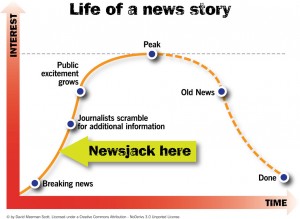by George Simpson, Featured Contributor, February 18, 2016
Neuromarketing research has been around since 1990, when it was developed by psychologists at Harvard. In a lab setting, it is supposed to measure changes in your physiological state and biometrics such as heart and respiratory rates and galvanic skin response to see how you respond to marketing stimuli, why you make the decisions you do, and which areas of your brain are in play when you do.
The technology is based on a model that asserts the major thinking part of human activity (over 90%), including emotion, takes place in the subconscious. Thus, we can only conclude that all of this is an attempt to learn the techniques of effective manipulation of subconscious brain activity.
This week we read that marketers and agencies are now turning to emerging technology — such as wireless EEG headsets, biometric scanners, and facial-and eye-tracking software — to understand the effectiveness of display and video ads on smartphones. This allegedly involves algorithms that can decipher how you felt during an ad or how long you looked at one. Other researchers are examining the role of brain activity, visual patterns, heartbeats and facial movements play in your response to ads.
Really?
While you might argue that all of these brainwave studies are simply ways to improve advertising efficiency (right message, right place, right time) the notion that marketers are poking around brain activity to sell more stuff is repugnant.
For a variety of reasons that are already familiar to you — from shitty creative to protracted ad pods, from “creepy” online tracking to algorithms that are driven by highly inaccurate data input — the public thinks that advertising as a profession ranks right down there with used car salesmen and serial killers (still, a mite higher than “Congressional representatives”).
Now, try to imagine how much more they will hate us when some enterprising reporter goes long-form on a summary of the efforts being made to get past a target audience’s conscious thoughts.
According to at least one psychology trade story, the current consensus among marketing professionals is that subliminal messages are counterproductive. Some in the business have misgivings about using this tactic in marketing campaigns due to ethical considerations. Moreover, recent studies have shown that efforts to brand or stimulate consumption via the subconscious simply don’t work.
Yet we persist. The public understands — and on most levels accepts — skunk works that dream up better ways to kill people through advancing technology (did you see the video of the machine gun that fires a million bullets a minute?). Most of them are pretty passive about research into genetically modified foods that can grow bigger, faster while resisting insects and fungus. But tell them about research built around breaking down their conscious resistance to greater consumption, and you give them just one more reason to hate this industry.
MediaPost.com: Search Marketing Daily
(108)
Report Post






